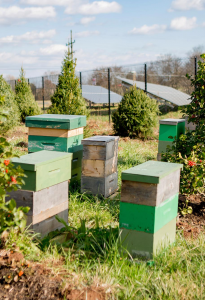Pollinators and Solar Farms

Pollinator populations are in decline in the United States due to environmental stressors including pesticides, parasites, diseases, and malnutrition.
Without appropriate vegetation and land management, the number of pollinators will continue to decrease, putting farms and crop yields dependent upon flowering plants at risks.
At the same time, solar energy projects are being developed in agricultural areas.
Cypress Creek Renewables is pioneering a new Solar + Pollinators Initiative. Co-locating pollinator-friendly habitats and vegetation on solar farms can support and expand local pollinator populations such as birds, bees, and butterflies and bring benefits to surrounding agriculture and the environment.
Pollinators provide an ecological service that is a requirement for more than 85% of the world’s flowering plants which is inclusive of most global crop species. Annually, around $3 billion is generated in the United States due to native pollinators’ services for over 100 crops.
- During the solar farm’s operation, soils rest and rebuild while the deep-rooted plants add organic matter and fertile topsoil.
- With pollinator habitat, stormwater runoff can decrease by 8-23%. A diverse mix of plans has stronger hydrologic performance standards than turf-grasses and other monocropping practices.
Guest content from Cypress Creek Renewables, Gold sponsor of the 2018 Green Tour.